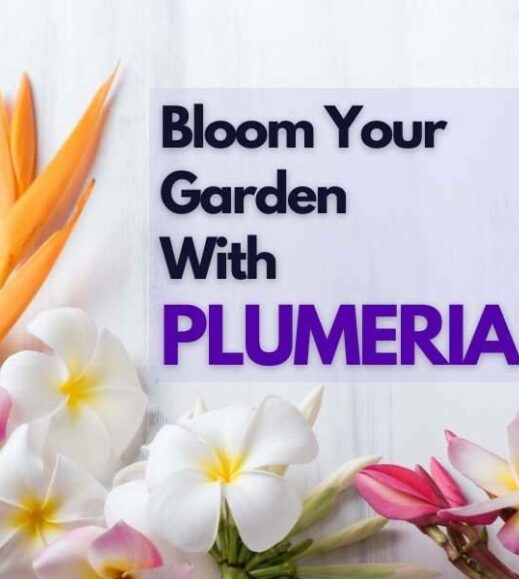Plumeria plants are one of the most popular tropical flowering trees. If you want to grow your own Plumeria at home or just need some basic care instructions for your existing Plumeria tree, continue reading!
What Is Plumeria Plant?
Plumeria is a fantastic tropical flowering plant. It is also known as the Hawaiian Lei flower and frangipani plant. You can find Plumeria in different shades of white, yellow, pink, orange, purple, lilac, and red.
Plumeria plants can reach up to 30 feet and bloom year-round with masses of fragrant blossoms between March and October. Plumeria is hardy in USDA zones 9 to 11 but cannot tolerate freezing winters since it is a tropical plant. For this reason, Plumeria should be planted in containers and brought indoors during winter.
Where to Buy Plumeria (Frangipani) Plant?
Plumeria (Frangipani) plants are available at most garden centers or online.
Types Of Plumeria
There are many different types of Plumeria:
- Plumeria rubra ‘Candy Stripe’
- Plumeria rubra ‘Vera Cruz Rose’
- Plumeria rubra ‘Sundance’
- Plumeria rubra ‘Thailand Red’
- Plumeria rubra ‘Diva’
- Plumeria rubra 'Toba's Fire.'
- Plumeria stenopetala
- Plumeria rubra ‘Makaha Sunn’
- Plumeria rubra 'Gabrielle.'
- Plumeria rubra 'Elizabeth Thornton'
Plumeria Care: How To Care For A Plumeria Plant?
Here's how to care for frangipani plant.
Plumeria Soil Requirements
Plumeria is a tropical flower that thrives in moist soil. Too much water can cause the tree to suffer from rapid dieback.
Plumeria requires well-drainage soil either in the ground or in pots.
Use the pot with well-drained yet aerated soil with plenty of air pockets where roots will proliferate. You can use an indoor potting mix or Miracle-Grow perlite for growing Plumeria.
Plumeria Sunlight Requirement
Plumeria typically needs at least 6 hours of sunlight. It is better to keep them in the south-facing window! Also, you can use a plant grow light for growing plants indoors.
To make your plumeria bloom, add two-bulb fluorescent lights just above it to increase the amount of natural daylight in the room.
Best Growing Temperatures For Plumeria
Since Plumeria is a tropical plant, it requires a temperature of about 18- 28 degrees Celsius.
If the temperature goes below 10 or 12 degrees Celsius, Plumeria shows a quick response by losing the leaves.
Watering: How Often Should You Water Plumeria Plant?
You don't have to water your Plumeria plant frequently since it is a drought-tolerant plant.
- Usually, you should water the Plumeria plant every 2 - 3 weeks on summer days. In winter, once a month is enough.
- If necessary, water the plant when its soil surface gets dry.
- You can also use the self watering spike planter drip irrigation watering kit.
Fertilizer: When To Use Fertilizer In Plumeria Plant?
Fertilizer is not required every year for the Plumeria plant. It should only be applied when the Plumeria shows slow growth, such as decreased blooming and leaf dropping.
The best time for fertilizing the Plumeria plant is in the winter days after it goes dormant or at least once a month during the summer.
- Fertilizers can be used once a month according to the amount and quality of the soil. Fertilizers containing phosphorus and potassium can be the best for this plant.
- While using fertilizers, never overfeed nitrogen as it will increase the foliage growth and decrease the blossom.
Plumeria food is one of the best fertilizers to grow Plumeria plant.
How Much Humidity Does Frangipani Need?
Unlike other plants, plumeria is not sensitive to humidity and does good in most conditions.
Plumeria Propagation: How To Grow Plumeria From Cuttings?
Propagation in Plumeria can be done by cuttings. The best time for plumeria propagation is spring, which can also be done in summer. But in winter, the soil isn't warm, so it is better not to propagate Plumeria in winter. Several stores usually have Plumeria Cuttings For Sale.
Plumeria Propagation: How To Plant Plumeria Cuttings?
Follow the following steps to plant plumeria cuttings :
- Firstly, select a healthy stem of the plant. Use a sharp blade to cut it
It is best to cut at about 30 cm long. - Leave the cutting for some days to dry out the milky sap.
- Cut all the leaves, buds, and flowers from that cutting.
- Prepare the soil by mixing 1 part of perlite and sand and 1 part of potting mix. Perlite and sand are for good drainage of the soil.
- Dip the cutting into root hormone powder and dip it into the soil you prepared.
- Then, pour the soil and gently press the ground around the cutting.
- Water your plant as necessary.
- Put your container or pot in a warm place.
- Root usually develops within 3-6 weeks.
Plumeria Propagation: How To Grow Plumeria From Seed Pods?
Plumeria Seed Pod And Plumeria Seeds
Here's the step-by-step guide to grow Plumeria from seed pods:
- Buy the seeds from any local nursery or online store.
- Prepare the soil in a tray with a good drainage potting mix. Then sow the seed in that soil.
- Cover the seed with the soil and gently press the ground around the seed.
- Make sure that the seed is in proper contact with the soil.
- Water the soil and keep the tray in a sunny place.
- It takes about two weeks for Plumeria seeds to germinate
Pruning: What's The Right Time To Prune Frangipani Tree?
Plumeria trees should be pruned in winter when the new growth has matured, as this will increase the chance for good blossom in spring.
Pruning helps maintain the size, remove the dead and damaged branches, and ultimately helps new growth.
Growing Plumeria In Pots
Yes, you can grow Plumeria in pots, but always remember to use a pot with a small or big drainage hole, according to its size.
Growing Plumeria In Pots: When Is The Good Time For Repotting Young Plants?
Repotting can be done in the spring season.
Dwarf Singapore Pink Plumeria - 5" Pot Live Plant
Plumeria Flower And Plumeria Scent
The sweet smells of these flowers are impossible to resist. There is a range of colors, like pink, reds, yellows, or pastels with bicolor! These scents hint at jasmine citrus and gardenia and smell excellent! Plumeria is often used to make Plumeria scented candles, Plumeria fragrance oil, and essential oil.
Plumeria Plant Pests And Diseases
Plumeria trees reach a height of 30' feet and are hardy to most insects. But few pests can damage Plumeria.
They include mealybugs and thrips (which are more common in winter).
These bugs will suck the sap from the Plumeria tree, causing stunted growth or yellow leaves. If you notice any bug infestation on the Plumeria tree, spray the leaves with insecticide.
Insecticidal Soap Organic Miticide
Bonide 811 Copper 4E Fungicide
The Plumeria plant is also prone to diseases like leaf spots and trunk rot. Treat these problems by using fungicides or spraying a copper-based product on the soil surrounding the Plumeria plant.
How To Treat Plumeria Black Tip Fungus?
Black tip fungus is caused primarily due to aphid feeding, which oozes a sugary secretion on the feeding site. This attracts many ants and other insects to the feeding site, which leads to the growth of fungus, turning the tip of the plumeria plant into a black, crusty, and sticky surface. If you see this happening, the black tip and the insects feeding on it should immediately be removed, and your Plumeria will regrow, giving out new shoots. You can also spray some fungicides.
Black tip fungus should not be confused with a back tip which occurs due to exposure of plumeria plant to frost or cold in the winter.

Looking for the best app to identify any plant using your iPhone or android?
FAQs
How do you care for a Plumeria plant indoors?
Since Plumeria requires 6 hours of direct sunlight in a day, while planting it indoors, you must keep it on your balcony or window where direct sunlight reaches.
Are Plumerias poisonous to humans?
Plumeria produces milk sap which is toxic and alkaloid and can affect people with sensitive skin. According to USDA, eating or touching any plant part may cause mild stomach pain, cramping, and skin irritation.
How cold can Plumeria tolerate?
Plumeria is a tropical plant that requires a minimum of 15 degrees Celsius, i.e., below 15 degrees Celsius, loses its leaves, and goes into the dormancy stage. So, for Plumeria, the temperature should be above 15 degrees Celsius.
Are coffee grounds good for Plumeria?
Generally, coffee grounds are acidifying in nature. And Plumeria requires slightly acidic soil to grow. So, coffee grounds are good for Plumeria.
Does Plumeria need full sun?
Yes, Plumeria needs full sun for at least 6 hours a day.
Where is the best place to plant a Plumeria tree?
The tropical region is the best place to plant a plumeria tree, with about 6 hours of direct sunlight and proper drainage soil.
Is it normal for Plumeria to drop some bottom leaves in the days after being transplanted?
Yes, Plumeria plants will often drop leaves after being transplanted. Plumeria will typically regain its fullness and leaf cover within one to two weeks.
Can I Use the Same Care Techniques for Dipladenia and Plumeria Plants?
Yes, the same care techniques for growing and caring for dipladenia can be used for plumeria plants. Both plants thrive in similar conditions, requiring well-drained soil, plenty of sunlight, and regular watering. They also benefit from occasional fertilizing and pruning to encourage healthy growth and beautiful blooms.
Do Plumeria plants grow blue flowers?
No, plumeria plants don't grow blue flowers.

How to master gardening? Download these essential home and gardening ebooks today!














